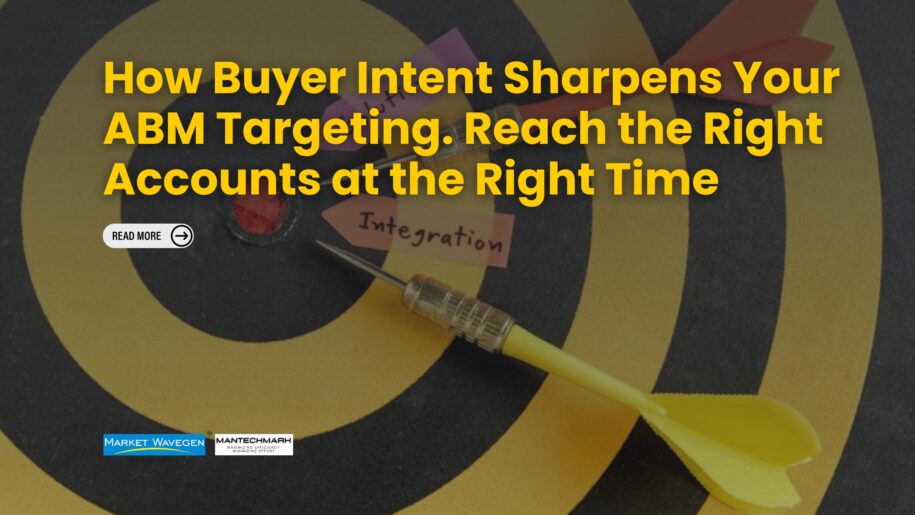Account-Based Marketing (ABM) has become a cornerstone strategy for B2B marketers seeking to nurture high-value relationships with targeted accounts. While traditional ABM relies on understanding an account’s firmographics (industry, size, location) and technographics (technology stack), a critical element often overlooked is buyer intent.
Buyer intent refers to the signals that indicate a company is actively researching or considering a solution like yours. This data can be a game-changer for ABM campaigns, allowing you to hyper-target accounts demonstrating active purchase intent and personalize outreach efforts for maximum impact.
In this blog post, we’ll delve into the power of buyer intent for ABM, exploring how it sharpens your targeting, personalizes your messaging, and ultimately boosts your campaign effectiveness.
Why Buyer Intent Matters in ABM
Traditionally, ABM relies on static firmographics and technographics to identify target accounts. While valuable, this approach can miss crucial signals: is the account actively considering a solution, or are they simply a good fit on paper?
Buyer intent data bridges this gap by providing real-time insights into an account’s current buying journey. Here’s how it elevates your ABM strategy:
- Prioritize Accounts Based on Active Interest: Instead of wasting resources on accounts that might not be ready to buy, buyer intent data allows you to prioritize those actively researching solutions. This ensures your outreach efforts land with the most receptive audiences.
- Personalize Messaging for Maximum Impact: Imagine crafting a message that directly addresses a specific pain point the account is researching. Buyer intent data reveals these pain points, allowing you to tailor your messaging to resonate deeply and demonstrate a genuine understanding of their needs.
- Optimize Campaign Timing: Buyer intent data often indicates where an account is in the buying journey. You can leverage this knowledge to deliver targeted content at the right time, ensuring your message aligns with their specific research stage.
- Measure Campaign Effectiveness More Accurately: By analyzing the correlation between buyer intent signals and conversions, you gain a clearer picture of your campaign’s effectiveness. This allows you to refine your approach and maximize return on investment (ROI).
Identifying Buyer Intent Signals
So, how do you identify buyer intent signals for your ABM campaigns? Several resources are available:
- Website Visitor Behavior: Marketing automation platforms track website activity, revealing which pages visitors view, how long they spend on specific content, and which forms they submit. This data can indicate interest in specific solutions or pain points.
- Content Engagement: Analyze downloads, webinar registrations, and social media interactions with your content. High engagement suggests an account is actively researching a topic related to your offerings.
- Search Engine Queries: Leverage tools like Google Trends or social listening platforms to track industry-related keywords and identify accounts actively searching for solutions.
- Third-Party Data Providers: Several companies specialize in collecting and analyzing buyer intent data across the web. They can provide insights into an account’s online behavior and research patterns.
While each source offers valuable data points, a comprehensive approach is crucial. Integrate these signals with your existing ABM data for a holistic view of each target account’s buying journey.
Leveraging Buyer Intent for Personalized Outreach
Once you’ve identified accounts demonstrating buyer intent, it’s time to personalize your outreach efforts. Here are some strategies to leverage buyer intent data:
- Craft Targeted Email Content: Tailor your email content to address the specific pain points and needs the account is researching based on their recent website activity and content downloads.
- Develop Personalized Landing Pages: Create custom landing pages that dynamically adjust content based on the visitor’s company and their recent search queries. This demonstrates a deep understanding of their specific context.
- Schedule Relevant Sales Calls: Instead of generic sales pitches, equip your sales team with specific talking points derived from buyer intent data. This allows them to initiate conversations that directly address the account’s current challenges and research focus.
- Retarget Website Visitors: Leverage retargeting ads to serve highly relevant content based on which web pages the visitor viewed on your site. This keeps your brand at the forefront of their mind as they progress through the buying journey.
Measuring the Success of Buyer Intent-Driven ABM (Continued):
- Lead Conversion Rate: Track the conversion rate of leads identified through buyer intent signals. Higher conversion rates indicate your efforts resonate with accounts actively looking for a solution.
- Sales Cycle Length: Analyze if buyer intent data shortens your sales cycle by identifying accounts further along in the buying journey. This demonstrates the efficiency of your targeting efforts.
- Pipeline Velocity: Monitor how quickly leads identified through buyer intent data progress through the sales funnel. Increased velocity suggests a more streamlined sales process.
- Return on Investment (ROI): Ultimately, measure the ROI of your ABM campaign. By integrating buyer intent data, you should see a higher ROI as you target accounts demonstrably ready to buy.
The Future of Buyer Intent for ABM
The future of ABM is all about dynamic insights and real-time engagement. As AI and machine learning become more sophisticated, expect to see buyer intent data evolve in exciting ways:
- Predictive Modeling: Advanced algorithms will analyze buyer intent data to predict future purchase behavior, allowing you to proactively engage with accounts on the cusp of a buying decision.
- Real-Time Alerts: Imagine receiving real-time notifications when a target account exhibits high buyer intent. This allows you to capitalize on immediate opportunities and personalize outreach instantly.
- Omnichannel Engagement: Buyer intent data will be seamlessly integrated across all marketing and sales channels, ensuring consistent messaging and personalized experiences at every touchpoint.
By embracing buyer intent data and continually refining your approach, you can transform your ABM campaigns into a powerful engine for generating high-quality leads and closing more deals.
Conclusion:
In the ever-evolving landscape of B2B marketing, ABM requires a data-driven approach that goes beyond firmographics and technographics. Integrating buyer intent data into your ABM strategy allows you to hyper-target accounts actively researching solutions, personalize your messaging for maximum impact, and ultimately achieve superior campaign results. By staying ahead of the curve and embracing the future of buyer intent data, you can ensure your ABM efforts deliver exceptional value and propel your business towards significant growth.


Leave a Reply